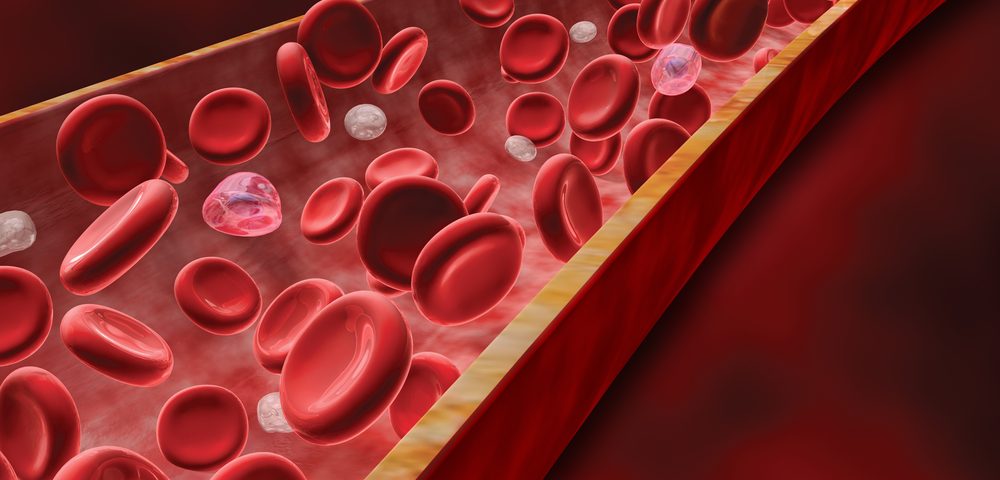The number of circulating tumor cells (CTCs) could help doctors choose between hormone therapy or chemotherapy for the first-line treatment of metastatic breast cancer patients whose tumors produce estrogen receptor (ER) but are negative for the HER2 factor, a Phase 3 trial suggests.
These findings were recently presented at the 2018 San Antonio Breast Cancer Symposium in San Antonio.
“Two main treatment options exist for patients newly diagnosed with metastatic, ER+, HER2- breast cancer: hormone therapy or chemotherapy (eventually followed by maintenance hormone therapy). There is, unfortunately, no validated predictive biomarker to guide that choice,” Francois-Clement Bidard, MD, PhD, professor of medical oncology at Institut Curie and the University of Versailles, said in a press release.
When doctors have to decide on a treatment, they prefer hormone therapy because there are fewer side effects associated with it, but for patients who have a bad prognosis, it is better to start with chemotherapy. However, because there are no reliable predictors of bad prognosis, different doctors might propose different treatments for the same patient.
In the past decades, the number of tumor cells in circulation have been suggested as one of the strongest predictors of prognosis in this patient population. Researchers designed a Phase 3 trial (NCT01710605) to determine if CTC count could be used as an alternative to clinical evaluation for choosing treatment in ER-positive, HER2-negative metastatic breast cancer patients.
The STIC CTC trial evaluated 778 patients. In half of them, the treatment was decided by medical advice (medical-driven arm). The other half, the CTC-driven group, received treatment based on their CTC count — hormone therapy if 7.5 ml of blood had fewer than five CTCs, and chemotherapy if the CTC count was higher.
As a primary objective, researchers tested if patients in the CTC-driven group lived at least as long without disease worsening as patients in the medical-driven group. Safety and overall survival were examined as secondary goals.
In the medical-driven arm, 72.6% of patients received hormone therapy, and 27.4% received chemotherapy.
The CTC-driven arm was divided into patients who would have probably received hormone therapy and those who would have probably received chemotherapy if they had followed medical advice.
In the first subgroup, hormone therapy was confirmed in 66.7% of patients; the other 33.3% were switched to chemotherapy due to a high CTC count. In the second subgroup, chemotherapy was confirmed for 48.1% of patients; the remaining 52.9% had a low CTC count and thus received hormone therapy.
The study met its primary goal, with patients in the CTC arm showing progression-free survival that was not inferior to that of the medical-driven group.
Interestingly, patients whose treatment was switched to chemotherapy due to a high CTC count lived 15.5 months without their disease progressing, whereas patients with a high CTC count who received hormone therapy following medical advice did so for only 10.5 months. This tendency was maintained for median overall survival — 42 months versus 37.1 months.
Patients originally assigned to chemotherapy who were switched to hormone therapy based on a low CTC count showed similar survival rates as those with a low CTC count who received chemotherapy in the medical-driven group.
“In our study, not only have we demonstrated that basing the decision on CTC count alone does not harm patients in the overall study population, but subgroup analyses show that, in the 292 patients with discordant treatment recommendations (between the clinician estimate and the CTC count), frontline chemotherapy was associated with a significant 35 percent decrease in the risk of death,” Bidard said.
“Since the 90s, no trial has assessed the question of front-line therapy, and our results suggest that modern prognostic biomarkers, such as the CTC count, may lead to better patient survival,” he added.
A major limitation of the study, according to Bidard, is that during the clinical trial, which started in 2012, CDK4/6 inhibitors (palbociclib, ribociclib, and abemaciclib) became popular first-line treatments for metastatic breast cancer, so nowadays doctors are more likely to recommend a combination of hormone therapy and CDK4/6 inhibitors than chemotherapy.

